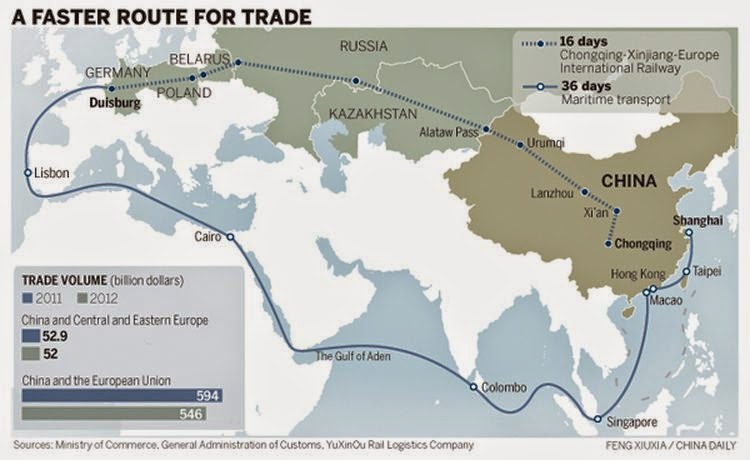China e Rússia se desinteressam pelo Ocidente e suas chantagens.
Puxam Alemanha para sua esfera de influencia.
Once upon a time not so long ago, Beijing’s leadership was flirting with the idea of rewriting the geopolitical/economic game side by side with the United States, while Putin’s Moscow hinted at the possibility of someday joining NATO. No longer. Today, the part of the West that both countries are interested in is a possible future Germany no longer dominated by American power and Washington’s wishes. A specter haunts the fast-aging “New American Century”: the possibility of a future Beijing-Moscow-Berlin strategic trade and commercial alliance. Let’s call it the BMB. Its likelihood is being seriously discussed at the highest levels in Beijing and Moscow, and viewed with interest in Berlin, New Delhi and Tehran. But don’t mention it inside Washington’s Beltway or at NATO headquarters in Brussels… the tectonic plates of Eurasian geopolitics continue to shift, and they’re not going to stop just because American elites refuse to accept that their historically brief “unipolar moment” is on the wane.
Business Insider - Yahoo News UK Oct 2014 - clik 1 - clik 2 - clik 3
Trem-bala Moscou-Pequim por 230 bilhões, 7.000 km em 2 dias.
The respective governments of China and Russia are seriously considering the idea of building a high-speed railway line between their two capital cities, according to reports.
As we have discussed earlier, the US tries to ‘isolate’ Russia and China, through Ukraine and Japan. As far as it is possible to isolate giant land masses like China and Russia in the first place. Perhaps it makes more sense to say that the US keeps its proxies EU and Japan isolated, by setting them up against Russia and China respectively. Instead China turns away from the ocean and concentrates on Eurasian development: Meanwhile, with the US Navy controlling global sea lanes for the foreseeable future, planning for those new Silk Roads across Eurasia is proceeding apace. The end result should prove a triumph of integrated infrastructure—roads, high-speed rail, pipelines, ports—that will connect China to Western Europe and the Mediterranean Sea, the old Roman imperialMare Nostrum, in every imaginable way.
Por terra, há nova mega rota de comércio Europa-Ásia. É fora dos oceanos, um domínio dos EUA.
A future network of Chinese-organized new Silk Roads that would create the equivalent of a Trans-Asian Express for Eurasian commerce. So if Beijing, for instance, feels pressure from Washington and Tokyo on the naval front, part of its response is a two-pronged, trade-based advance across the Eurasian landmass, one prong via Siberia and the other through the Central Asian “stans.” In other words: let the US own the oceans, so they can use their king size navy to regulate whale traffic there, while China does business with Russia and Europe… over land. Exit global controller and thalassocratic power USA.
A future network of Chinese-organized new Silk Roads that would create the equivalent of a Trans-Asian Express for Eurasian commerce. So if Beijing, for instance, feels pressure from Washington and Tokyo on the naval front, part of its response is a two-pronged, trade-based advance across the Eurasian landmass, one prong via Siberia and the other through the Central Asian “stans.” In other words: let the US own the oceans, so they can use their king size navy to regulate whale traffic there, while China does business with Russia and Europe… over land. Exit global controller and thalassocratic power USA.
Business Insider - Yahoo News UK Oct 2014 - clik 1 - clik 2 - clik 3
Trem-bala Moscou-Pequim por 230 bilhões, 7.000 km em 2 dias.
The respective governments of China and Russia are seriously considering the idea of building a high-speed railway line between their two capital cities, according to reports.
The Beijing Times said that the line, which would be over 7,000 kilometres but cutting the Trans-Siberian railway journey from six days to two, would cost in excess of $230bn (£142.9bn, €179.5bn) if it is toconnect Moscow and Beijing via a high-speed railway line. If it were to be completed, it would be triple the length of the world's longest high-speed line which runs from Beijing to Guangzhou. Wang Meng-shu, a tunnel and railway expert at the Chinese Academy of Engineering, told the Beijing Times: "If the funds are raised smoothly...the line can be completed in five years at the quickest."
Vladmir Putin and Premier Li Keqiang signed a memorandum of understanding when China's head of government travelled to Moscow earlier in the week, with the duo outlining their interested in building a high-speed link between Moscow and Kazan in the Tatarstan region, an area which holds vast amount of oil, China Central Television (CCTV) reported. It was reported earlier in the year that China was considering building a 13,000km high-speed railway line that would run from Beijing to east coast US. The line, creatively dubbed the China-Russia-Canada-America line, would begin in Beijing, travel north through Siberia, and under the Bering Strait to Alaska before heading south through Canada to reach its final - unspecified - destination in the United States.




